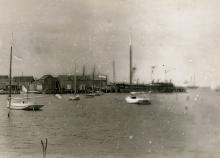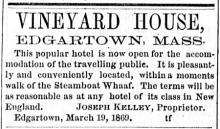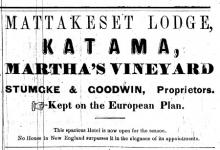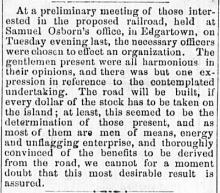These were the last survivors of the Vineyard’s most ambitious project. Of course the right of way is an intangible thing at best to any but the owners. And it was sold. As for the streak of rust. Well, a spirit of economy which never characterized the scheme in its heyday finally removed the rails of the first and last railroad on the island.
It would never do to begin at the end and trace first the decline and fall of the era of the iron horse, but in order to convince the present generation that such things could be if they are not now, it is necessary to dwell upon the streak of rust that was and the occasional “sleeper” that remains half buried in the sand along the line of the triumphal road, and the pathetic remnants of the trestle work of the bridge which once spanned Menada Creek on the water side of the present structure.
No one who witnessed the gala opening of the narrow gauge road from Oak Bluffs to South Beach, via Edgartown and Katama could ever forget that day and hour. Hope long deferred had made the hearts of even its promoters sick at the long delays involved. As the summer of 1874 waned they counted not their blessings but the money bags they might have banked if the road had opened with the season. As for the townspeople, pride in the island made them impatient for the great event. And the summer visitors, ever ready for a new sensation were perhaps a little amused, but genuinely anxious.
News from the mainland told of one disaster after another that had overtaken the engine destined for island duty. Finally it got as far as Woods Hole, but before it could be loaded on a steamer, some freight cars attacked it and plunged it into the water, from which near-grave it was fished up with difficulty.
But one day, August 22 to be exact, the Island Home reached Oak Bluffs with a mysterious object looming up on her deck. No presidential candidate was ever greeted with greater fervor than the Vineyard showed in its welcome of that ten ton engine. The noise was contributed about equally by a band, fire crackers and some thousands of spectators. Scarcely had it been unloaded when the engine was put to work, carrying the directors of the road, their invited guests and any others fortunate enough to crowd on, along the beach road, across Edgartown and up to the South Beach, hitherto reached laboriously by horse or foot by the trails across the plain.
And the effect? Here is what the Vineyard Gazette had to say on the subject in general, and it must apply more particularly to the initial day.
“The iron horse now speeds from Oak Bluffs to Katama and returns with the swiftness of the wind. The snort of the engine causes the cattle on a hundred hills to skip and jump like rams.”
Wrote, “Wallingford”, a “sober horse in a yard we passed - an animal of strong wind and feeble body bones, and a candle burning inside - a ghostly looking animal of this description, we repeat, stood leaning against a fence to keep his feet when with a roar and a rush the engine passed him. That horse was a lost lunatic for the space of a minute! He woke up all over at once, and the way he worked away from that locomotive in successive somersaults was highly exciting to spectators. We noticed him as we came back, trying to climb a tree in the farthest corner of the field.”
A Steed With Tremens
The sober horse was not alone in his agony. He had for companions every four footed animal within hearing distance, including another poor steed who developed tremens, “whose eyes stuck out ahead of him and got to Edgartown first by some lengths.”
All along the roadway spectators gathered, cheering. The “vicinity of the station was black with people.” Speaking of stations, do you know where Edgartown was? In the vacant lot on Main street, just this side of the jail. There was a shack at South Beach and the wharf at Oak Bluffs served the purpose of a station. When the Island Home deposited its precious freight on the Oak Bluffs wharf a line of track was run clear down to the end of the dock, and the triumphal progress began at once. Later on, the train ran only a short distance down the wharf. In place of a turn table the track was laid in triangular fashion. While the cars remained in front of the old Sea View House, the engine puffed and snorted and fussed its way down one side of the triangle, up the other, and hitched on right side forward. The same method was used at South Beach.
Everyone who was anyone, from presidents own, rode on the Martha’s Vineyard Railroad. President Grant happened down within a few days of the opening and he and members of his cabinet, were perhaps the most distinguished passengers.
Really you’d be forgiven if when you gazed upon the picture of the island’s pride, you were reminded, whether or no, of the miniature railways that every well regulated exposition furnished for the delectation of the young idea. The ballooning skirts of the ladies in the picture quite put the poor engine in the shade.
But how far wrong you would be if you got an idea like that in your head. For “The Active” was every inch an engine, even if she weighed only ten tons, and was constructed for narrow gauge work. If she hadn’t been she could never have followed that strange and precarious route along the very edge of the water. Could she travel? Well, there was a diamond robbery reported one night from the fashionable Mattakeesett Lodge. “Full Speed ahead” came the order and she swept down the track like a mad thing, reaching Katama in nine minutes from Oak Bluffs.
Probably Chief of Police Jason L. Dexter, father of Thomas L. Dexter, for many years a member of the state police and engineer Baxter, who came from the Old Colony Road had no time for visions of sudden death, but the grinning specter himself must have shared that wild ride. It is not recorded whether the speed helped solve the loss of the jewels reported by Mrs. Robert B. Green, of New Bedford, but it must have given city folk a starting example of island enterprise.
A Speed Limit
As a matter of fact, so expert was Mr. Baxter in handling The Active that his time between Edgartown and Oak Bluffs hardly ever exceeded ten minutes, until he and his impetuous charge were curbed with an order that they should consume fifteen minutes in the passage.
William H. Cottle of Edgartown who fired The Active during the first six years of the road, remembers making the trip from Oak Bluffs in seven minutes, at least once. He worked with Henry R. Luce for a time, for firing was more than a man sized job when you had to get up steam before 5 to meet the early boat and the train was still rumbling over the track at 11 and sometimes midnight. He says the train was crowded on every trip during the summer time. It ran hourly between its terminal points from the greater part of the day and there were excursions besides.
No sooner did some enterprising soul in Oak Bluffs erect a sign, “Big Surf at South Beach,” than there was a stampede of summer visitors for the train, which was crowded beyond capacity, carrying people back and forth to gaze on what is perhaps the most gorgeous sight the Vineyard has to offer.
Mr. Cottle remembers no accident to passengers during the existence of the railroad, though in its later years, it dispatched a cow or two, which probably thought it had a fellow of its own size to contend with, didn’t succeed in wrecking the train.
From tidy revenue from the railroad, which was said to reach $12,000 a year, shows how heavy the patronage was during the summer months. It cost thirty five cents one way between Edgartown and Oak Bluffs, and fifty cents the round trip from Oak Bluffs to Katama, with a clambake thrown in. And those clambakes! They don’t come like that any more, say the old residents in regretful tones.
Henry Ripley was the first superintendent on the line and Grafton H. Collins and Shubael Lyman Norton were the first directors. Nathaniel Jernegan was also closely identified with the project. The president was E. Carpenter of Foxboro, president of the road. Only four of the present residents of the Vineyard were actively connected with the road, W. H. Cottle, Henry R. Luce, Eben D. Earl and Harry Collins.
Harry Collin’s Debut
Harry made his debut in business on the Martha’s Vineyard Railroad in 1890, and stayed with the road until its decease. His was not the least important duty, that of supplying the inner man of the passengers with delectable popcorn, pink, brown, white and yellow, in fact the very same kind of popcorn, through his present wares are strictly fresh, that he still markets every summer. Harry remembers that in spite of the fact that it may have broken speed laws now and then, the train slowed up at every crossing and gave three long toots from its whistle. What more could you ask in the way of safety first?
That “the gentlemanly conductor” was no misnomer for that official or the engineers, baggagemen, firemen and brakemen, not mentioning the station agent, is proved by the performance of one incumbent who, witnessing a thrilling runaway inspired by the speeding and coughing “Active” closely followed by the tender, the baggage car and the three coaches which accompanied it in the height of its success, stopped the train in mid flight, backed up to the scene of the catastrophe and gave the frightened heroines a free ride to their destination.
John B. Worth, Edgartown born, and for years proprietor of a grocery in Oak Bluffs was the first conductor and W. P. Whittemore, from off-island, the first engineer H. Adlington, father of Shubael Adlington of Old Acres, was for many years the brakeman. William E. Marchant was conductor for three years and Holmes C. Fisher brother of Miss Sabra Fisher also held that office. Most of the engineers were strangers, although Henry R. Luce was filled that position for a time.
Those were the good old days, which at one time or another favor island railroads as everything else in the world. Year by year the minutes lengthened until finally it took a whole half hour between the two towns. The mania for speed had burned itself out, just as the road bed had got itself washed out winter after winter until from being one of the smoothest in the country, as smooth as sea glass, it was indeed a rocky road to travel. The accommodating conductor stopped along the road to take on passengers. Probably if there had been flowers to pick in the sand no one would have protested the delay, and it is rumored that the train used to rest in the sunshine while everyone took a turn at the fishing line.
Katama and Its Passing
The last days of the railroad were not so painful, nor did they come so soon as those of the great Katama project which in some part prompted the building of the railroad.
In some minds had dawned a vision of a second Oak Bluffs which should blossom on the broad plain which stretches toward the South Beach. The development of Katama was boomed in part by the same men who had sponsored Oak Bluffs, and they wanted another in its own image. Stumcke, a former hotel manager in Cottage City handled the fortunes of the new Mattakeeset Lodge, which was crowded to over flowing year after year. A clam bake house was erected and proved immensely popular for transients as well as paying guests. Several small cottages were erected to house the overflow. There was an excellent wharf, stretching out into the fair waters of Katama Bay. Island streamers, and larger vessels, the Granite State, The Elm City and other big boats, docked there in the days when eight or ten excursion steamers were no uncommon sight at Oak Bluffs wharf.
One of the greatest splurges staged during the time of Katama’s popularity was the fox hunt which was put on as ceremoniously as if it had occurred on a great English Estate. A pack of twenty hounds and hunters in appropriate garb were in hand and were admired by an audience of thousands. Jared W. Coffin, former postmaster of Edgartown, was so overcome with enthusiasm that he whipped up Dobbin, attached to a carryall, containing the whole family, in a vain attempt to be first at death.
Of it all, there is left - nothing not even ruins. The wharf is gone, the clam bake house burned, the available portions of the hotel removed. One section is serving now as an able annex to the Harbor View Hotel. The removal of the building was preceded by the most notorious sack in Vineyard history. Year after year the hotel, abandoned, but still private property, was visited by veritable armies of vandals, who stripped it of all its furnishings, even making away with the ivory from the piano keys.
Many reasons have been advanced for the failure of Katama to materialize as a permanent summer resort. Among them is the belief that it was purposely abandoned to its fate by the backers for fear that it might in fact develop into a second Oak Bluffs, and wrest away the laurels of that town, which at that time had no rival. At any rate Katama, on the west shore of the bay and about three quarters of a mile from the South Beach is dead and forgotten in spite of an extraordinary popularity, and an ideal location. Many of Edgartown’s first citizens, who had won fortunes in whaling, lost heavily in the venture.
The Decline and Fall
How long the road might have lasted if it had been built on a firm foundation is a matter for conjecture. There’s no disputing the fact that the route of the nine mile road was one of more scenic beauty to the inch than you find on most grown up railroads to the mile. Down the magnificent sweep of open sea where the beach road now winds, the tracks hugged the water front. In those days the shore stretched out many feet further than it does now, so that at the beginning the railroad seemed fairly secure. Each year great storms washed out yards of track and washed beyond recall inches, almost feet of shore, so that the road hovered on the very brink.
But passengers gave little thought to the practical difficulties of a ride which gave them free and unobstructed view of ever changing waters of the Sound. Nearing Edgartown the road turned abruptly, and breasted the gentle rise toward the town, winding through fragrant pine groves, and glimpsing the delights of the old whaling town which it crossed almost at right angles. On it went across the plain, which in its way is as picturesque as any other part of the road, past gay Katama and the very breakers of the great Atlantic.
Passengers raved about the beauty of the ride. Workmen raved about the impossibility of keeping the road in repair. All winter lo the latter labored, and still their work was never done. Bills for their services, new tires, etc, cut heavily into the surplus piled up by the railroad. When the original owners threw up their hands after twenty years of trial, one Joseph M. Wardwell of Bristol, R. I. purchased the road, which was then pretty far gone “in the suds” as one informant phrased it. The road proved too expensive for a wealthy man’s plaything, and when it was finally condemned by the Railroad Commission, no one took up the burden. The engine was sold and at last reports was doing duty on the subway in East Boston.
“That the whistle of the locomotive may be heard upon Martha’s Vineyard is among the probabilities of the immediate future. All hail to the new venture,” wrote the enthusiastic editor of the Vineyard Gazette at the first rumor of the impending event. Later he referred to the era of the steam cars as “the Golden Age of the Vineyard.” Well, the iron horse has come and gone, but who would say that the golden age of the Vineyard has passed. Of the past glory of Katama there remains not a trace, of the railroad, there is let less than a right of way and a streak of rust, but the Golden Age has survived the screech of that lusty whistle, whose last echo sounded twenty five years ago.










Comments